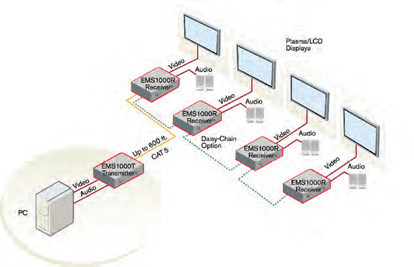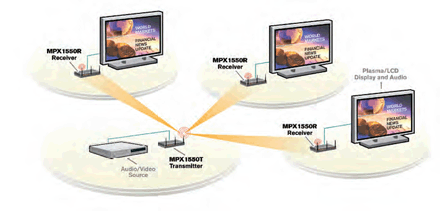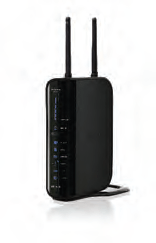For some digital signage installations, the wire-free way is the best way One of the most common questions facing designers and implementers of digital signage systems is: Which is better, wired or wireless extension? As you might expect,
both solutions are valid and each has a rightful place in your integration toolkit.
So when is it appropriate to shun the wire strippers, clippers, and crimpers in your toolkit and grab for an antenna instead? As you might expect, there are no hard and fast rules when wireless video extension is more advantageous than wired extension, but the guidelines offered in this article should help you reach a sound decision.
Terms such as wired and wireless extension solutions are rather loose and can mean different things to different people. To set bounds, let’s define these terms.
WIRED AND WIRELESS SOLUTIONS DEFINED
Wired extension, in this article, will refer to analog UTP extenders, which are also commonly called Cat5 extenders. Figure 1 illustrates a typical UTP video extension solution. This solution is characterized by video distribution over dedicated UTP cabling. The value delivered by these wired products is three-fold:
1. Video extension allows displays to be installed in public locations while PCs are securely housed and maintained.
2. Video splitting allows a single video signal to be displayed on multiple display devices and conversion to Cat5 greatly reduces the cost over conventional 6-wire coax distribution systems.
3. In terms of reduced cost of PC hardware and maintenance, these extenders provide a very real return on investment.

Figure 1: Typical UTP Extension Solution wireless video extension solution. These solutions are characterized by video distribution over industry-standard wireless Ethernet radios. Various distances are supported. When using standard omnidirectional antennas, receivers can be spread out around the transmitter within a 300-foot (100m) radius. With directional antennas, communication can be established up to 1000 feet (330m). For wireless transmission over greater distances, such as many miles, external Ethernet bridges may be used.
As with wired extension solutions, wireless solutions offer both video extension and video splitting capability. They also offer unique connectivity and management features, which can increase your return on investment.
LIMITATIONS OF UTP EXTENDERS
As mentioned previously, video over UTP extenders offer real-world benefits in terms of source device security, ease of maintenance, and distribution/splitting of analog video signals. For confined signage applications, these products offer a suitable solution. There are limits, however, to the usefulness of these products.
Many limitations and challenges arise from the wired nature of these products, as follows:
Turf wars: As the worlds of AV and IT collide, administrators are increasing demanding adherence to network-centric wiring practices. Installation of cable lengths exceeding 100 meters is potentially damaging to networks. Preferred cabling should be Category 6 or 7. These standards are at odds with UTP video extenders, which tout distances up to 1000 feet and work best over low-skew Category 5 cable. For these reasons, the return on investment for analog UTP cabling is likely to be short-lived.
Installation expense: Retrofit installations are particularly challenging. Installation of AV cabling is often an afterthought, requiring new conduit and wall plates. Factors such as union labor, city permits, and job inspections can greatly increase costs and introduce schedule risk. Business disruption is a factor in retail venues. Installation fees are often bid low, but the actual bill comes in high, thereby eroding hard-earned profits.
Wiring hazards, barriers, and environmental challenges: Wiring challenges are commonplace. For example, island-like informational displays in airports and shopping malls are best placed in the middle of a room surrounded by tile flooring. Hanging displays and in-elevator displays are also a challenge. Gas station pump-top displays may receive video from inside the store. Railway information displays are often separated from their source devices by a series of tracks. Older buildings, including “modern” airports, still have asbestos-based ceiling tiles that cannot be removed without adhering to expensive abatement procedures.
High finish requirements: Many applications involve highfinish environments, such as corporate conference rooms, house of worship applications, ballrooms, hospitality meeting rooms, museums, and historical buildings. In these environments, drilling holes for installation of conduit is either discouraged or prohibited.
Permanence: Permanence is a good thing for installations that remain static forever. Businesses, however, are dynamic. Retail establishments routinely modify building traffic flow to shift attention from one set of products to another. Rental and staging applications such as banquets, trainings, and concerts are transitory by nature. Municipal and city budget constraints are pushing schools and courtrooms to share AV equipment among multiple rooms. In all of these cases, mobility is more important than permanence.
Single point of failure: UTP extension cables are somewhat similar to serially connected Christmas tree lights; one break in the wiring and downstream displays go black. This lacks the degree of robustness that is desired for commercial applications.
Additional limitations result from the fact that these are inherently analog products:

Figure 2: Typical Wireless Extension Solution query the capabilities of the display so those features can be made available to the user. Thus, analog systems do not easily embrace upgrade or extension.
No support for protected content: Content protection schemes, such as HDCP, rely upon digital keys that are stored in display devices. Because UTP extenders do not support a digital backchannel, it is not possible to pass these keys.
Lack of digital video formats: As DVI-D and HDMI displays become increasingly pervasive in the market, the long-term viability of analog extension and non-standard cabling is called into question.
Distance sensitivity: As previously described, UTP extenders are sensitive not only to cable lengths, but also to twist ratios within a cable. Time-consuming tuning of each end point is required when installing these systems.
Ghosting: If cable lengths exceed the maximum supported length or if twist ratios result in more skew than de-skew circuitry can handle, then uncorrectable fuzzy video will result.
Extender burnout: Analog UTP extenders rely upon slight variations of voltage to encode color information. These subtle analog voltage variations are compromised if passed through optical couplers or transformers, which are the primary defense against ground loop current, which occurs when two devices connected to different ground planes are interconnected via a data cable. These damaging currents cause UTP extenders to run hot and burn out over time. Network and wireless devices are not vulnerable to ground loop damage.
Limited investment protection: Because PC markets are trending toward digital video, the life expectancy of analog-only extension products is somewhat limited.










